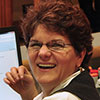This article is more than 5 years old.
This morning, Heather, Steve, Leslie and I (and I saw Lynn in the audience too) all attended the keynote speech given by Lolly Gasaway at the WFU Law School’s symposium “Copyleft vs. Copyright: Artist and Author Rights in Tomorrow’s Digital Age.” The focus of her keynote was to give some copyright context and layout the issues related to the inadequacies of copyright law to deal with digital authorship.
Copyright history in four quick sentences: Copyright was codified in 1790 in the US Constitution giving authors the ability to retain the rights of use for their fixed work in “science and the useful arts” for a limited time. It was codified in order to PROMOTE learning and expansion of ideas. The copyrighted work needs to be creative and fixed in form (ie written down) so facts, ideas, processes and discoveries are not copyrightable. The rights that an author retains for this fixed time include the control over 1. reproduction and distribution, 2. adaptation, 3. performance, 4. display/transmission, 5. display (which has been expanded to viewing a digital copy), and recently a 6th. Public performance of sound digital recordings.
The right of “first sale” says that if an individual purchases a copy of a work, that person can give or lend that work away to whomever they want to. (This is what allows libraries to lend their purchased copies.) But because only one “copy” was purchased, it cannot be legally duplicated, making two copies where there was only one purchased. How does this pertain to an electronic book for instance? Can I send you a copy of the e-book I’ve purchased as long as I delete my own? No, because in copying it to the second user, I’ve created a new copy, even if I delete the first.
Nuances abound! (its what I love and hate about copyright). The classroom exemption allows for performance of part of a work in a face to face context for educational purposes. If the public is invited in to view the performance, the ability to claim “fair use” goes away and that is then an infringement. The TEACH act gives educators the right to use streaming technologies to digitally provide reasonable and limited portions of a full length production. How much is “part” of a work? “Part” of a work is not identified, but the length allowed should only be what is educationally necessary to fulfill the teacher’s purpose.
Why is copyright under so much stress? In a digital environment, copies are made all the time, whenever we open a browser and view a document online. How can copyright law be changed to protect or prohibit that use? Infringement is so easy now.
Lolly discussed the Digital Consumer’s Bill of Rights which provides a framework for what consumers expect to be fair use in a digital age, (though its unclear if it will provide a legal defense). She also discussed the Digital Millennium Copyright Act and how it provides certain protections to ISPs for unknowingly distributing pirated material. Then she closed with her 12 (actually 13) “concerns for copyright” in a digital age:
1. Is copying the right metric for judging infringement?
2. P2P file sharing- suing people for downloading music?
3. Use of thumbnail images
4. Is caching copying?
5. The Google book settlement
6. Circumvention in countries where copyright laws differ from ours
7. Private copying where no money will change hands
8. Changing business models of owners.
9. User generated content
10. User expectations are changing
11. What about mashups?
12. Digital preservation?
13. How to deal with orphan works.
That was just the keynote! More on the panel discussion next week. Stay tuned!

3 Comments on ‘Copyright/Copyleft Symposium at WFU Law School’
Thanks for writing this up!!
I have nothing to add, that was an excellent summary!
Thanks for writing such a thorough summary! I’m sad I had to miss this last Friday, but I’m glad I didn’t have to miss the info.